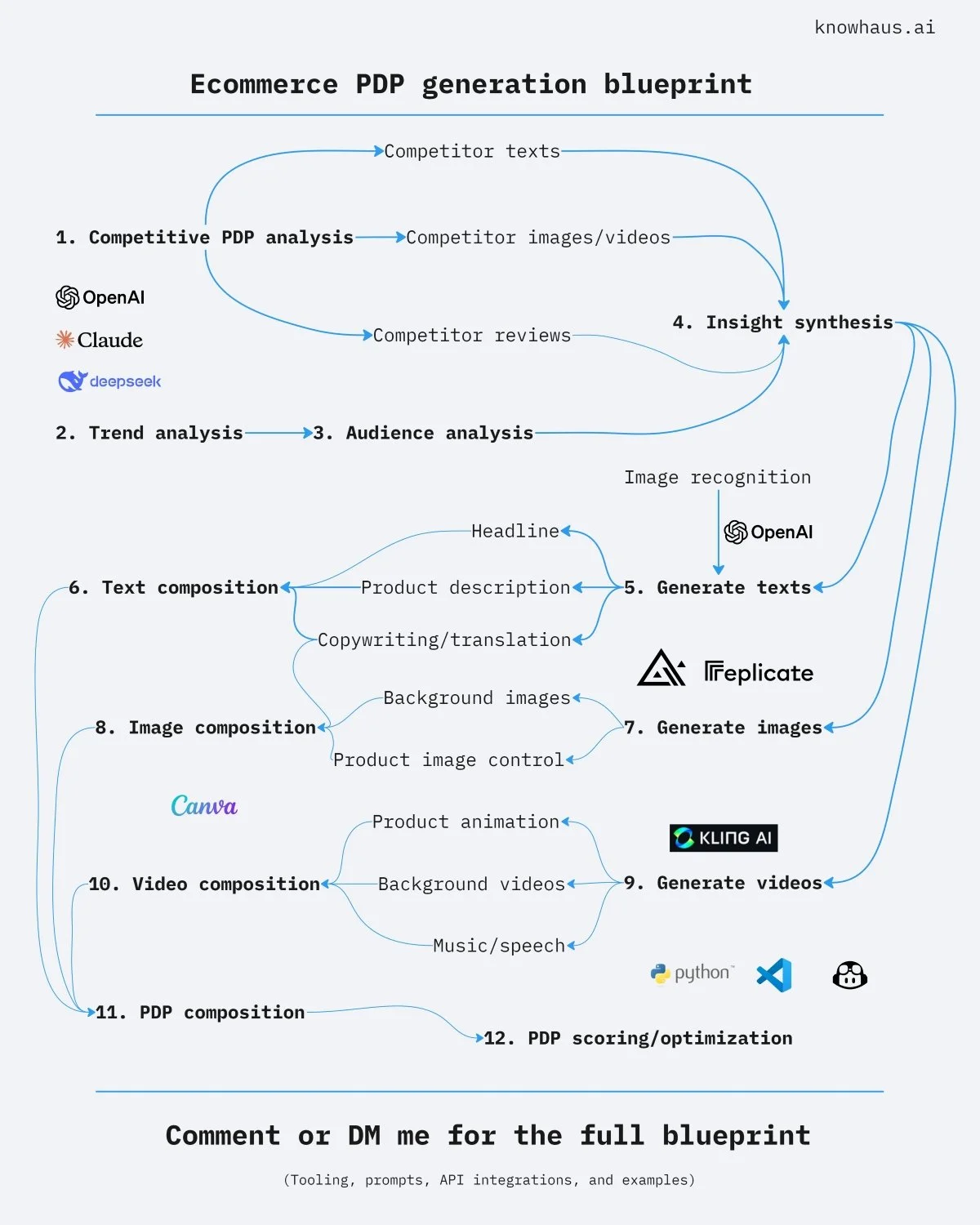Ecommerce PDP generation: workflow and AI tools
The product detail page (PDP) is the backbone of eCommerce success. A well-optimized PDP can increase conversion rates by up to 30% and improve organic traffic by 40%. With AI-driven automation, brands and retailers can now streamline PDP creation for scale, personalization, and efficiency. In this post, we’ll explore why PDPs matter, the key components of high-performing pages, best practices from top marketplaces, and a 12-step AI-driven workflow to generate them effectively.
1: Importance of PDP for Ecommerce
Why PDPs Matter: Facts & Figures
Product detail pages (PDPs) play a critical role in driving conversions and customer trust. Studies show that 87% of online shoppers say detailed product content is key to their purchasing decisions. Additionally, high-quality PDPs can increase conversion rates by 20-30% and improve organic search visibility by over 40% due to SEO-friendly content.
Traffic & Conversion Impact
Poorly optimized PDPs lead to lost opportunities. On average, 98% of eCommerce traffic does not convert on the first visit. However, PDPs with strong visuals, compelling copy, and structured specifications reduce bounce rates by up to 50%. Moreover, adding video content alone boosts conversions by 80%.
The Role of AI in PDP Optimization
AI-powered tools now analyze consumer behavior, competitor pricing, and trends to automate PDP creation. AI-driven A/B testing ensures that the best-performing elements are presented to different audiences, leading to increased engagement and higher purchase intent.
2: Key Components of PDP
Product Title: The First Hook
The title is the first touchpoint between a customer and the product. A well-optimized title should:
Include primary keywords (e.g., "Wireless Noise-Canceling Headphones")
Stay within 50-80 characters for readability
Highlight core selling points (e.g., “Best for Travel | Hi-Res Audio”)
Product Description: Communicating Value Clearly
Short Summary
A two-line introduction summarizing the product's core benefit for quick scanning.
Features & Benefits
Use bullet points to highlight key specs (e.g., battery life, material, compatibility).
Clearly state benefits instead of just listing features (e.g., “Noise cancellation for distraction-free work”).
USP Highlighting
What makes this product unique? (e.g., “50% faster charging than competitors”)
Manufacturer Information & Structured Specification
Brand trust increases when origin, materials, and certifications are included.
Use tables for structured data (dimensions, weight, materials, warranty info).
Images & Videos: Visual Storytelling
Number, Type & Quality of Images
5-8 high-resolution images (product shots, lifestyle images, close-ups of key features).
360-degree images for better product visualization.
Video Content
Short explainer videos (30-60 sec) boost engagement.
Unboxing and usage demonstrations provide real-world insights.
3: Best Practices from Top Marketplaces
Visual-First Approach: The Role of Infographics
Shein and Temu use infographics to visually highlight key features, making information digestible.
Amazon A+ content incorporates graphics and comparison charts for quick insights.
Usage Scenarios & Benefits
Tmall and JD show real-world usage through carousel images and scenario-based videos.
Emphasizing lifestyle integration (e.g., “Perfect for Gym, Office, and Travel”).
Trust & Social Proof Strategies
Customer reviews with images significantly increase conversions.
Trust badges (e.g., “100% Authentic,” “Certified Organic”) build confidence.
4: 12-Step Ecommerce PDP Generation Blueprint Using AI
The key to AI-enabled PDP generation lies in modularity. By breaking down the process into distinct modules, we leverage AI to generate each component separately before seamlessly composing them into the final creatives and PDP. This structured workflow follows 12 essential steps:
PDP generation blueprint
Step 1-4: Research & Insights
Competitive PDP Analysis: Study competitors' high-performing PDPs.
Trend Analysis: Use AI to analyze trending keywords and consumer demand shifts.
Audience Analysis: Identify key buyer personas and pain points.
Insight Synthesis: Combine research data to define key selling points.
Step 5-8: Content Generation
Generate Texts: AI tools like ChatGPT or Claude create optimized titles, descriptions, and FAQs.
Text Composition: Structure the content into a persuasive format.
Generate Images: AI image generators such as FLUX on Replicate create product visuals from multiple angles.
Image Composition: Optimize images for clarity, color correction, and background removal.
Step 9-12: Multimedia & Finalization
Generate Videos: AI-generated explainer and lifestyle videos enhance engagement.
Video Composition: Edit and combine clips for a polished final video.
PDP Composition: Merge text, images, and videos into a compelling page.
PDP Scoring & Optimization: AI scoring tools test variations for continuous improvement.
Conclusion
A well-optimized PDP boosts conversions, SEO rankings, and engagement. By leveraging AI-driven modular content creation, brands can streamline PDP generation at scale while maintaining high quality. Whether selling on a DTC website, an app, or a marketplace like Amazon or Tmall, a structured, insight-driven approach is key to maximizing sales.

